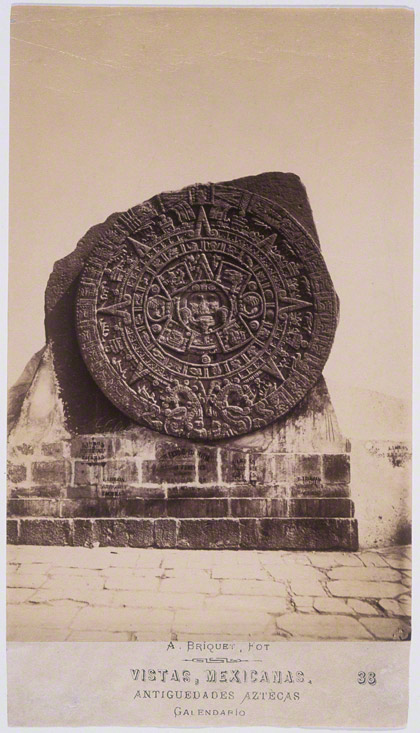
The Aztec Calendar Stone
The Aztec Calendar Stone, or Piedra del Sol, was buried a few decades after the conquest beneath what is now Mexico City's main plaza, or Zócalo. It was rediscovered in 1790 and mounted on one of the towers of the Catedral metropolitan, where it remained until 1885.
The central image of the massive basalt sculpture depicts either the sun deity Tonatiuh or the earth god Tlaltecuhtli. Although the 20 days of the 260-day calendar appear on the monument, it is not a calendar; rather, it is a sacrificial altar that the Aztecs called a cuauhxicalli, or "eagle vessel."
The Calendar Stone is the most famous ancient Mexican sculpture; it has been reproduced over the past two centuries in all mediums and at almost every scale. Although images of the Calendar Stone differ greatly in accuracy, they are all refractions and reflections of the original Aztec monument that was dedicated by Motecuhzoma II just a few years before the conquest.
The First Image of the Aztec Calendar Stone
The Mexican writer Antonio de León y Gama hired Francisco de Agüera, a Mexican artist best known for his religious prints, to make the first image of the Aztec Calendar Stone just months after it was discovered. His surprisingly accurate engraving illustrated the first treatise on the monument, published in 1792.
Agüera's image of the Aztec Calendar Stone and León y Gama's interpretation of the sculpture as an astronomical and timekeeping device influenced writers about the Aztecs for almost a century.

The Aztec Calendar Stone in the Museo Nacional
Photographers capitalized on the late-nineteenth-century demand for souvenir images of Mexican antiquities. Here, the Aztec Calendar Stone, one of the most popular subjects, is depicted in its new location in the Museo nacional after it was removed from the Catedral metropolitana in 1885.

